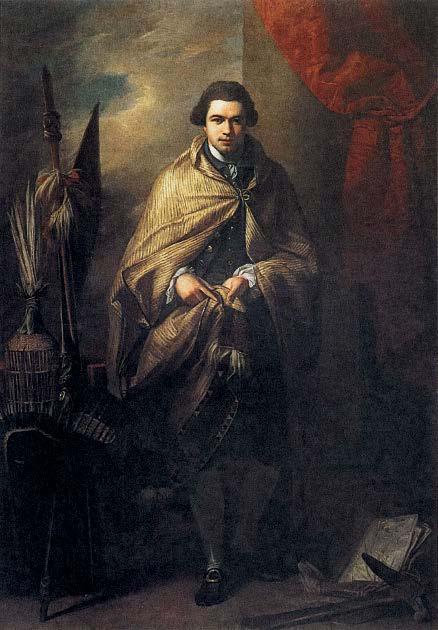
4 minute read
Acknowledgements
from Tattooed History
perfect his scars being clearly explained the hole in the Cheek & under the Ear was his Death Wound.9
King had been lieutenant-governor of Norfolk Island from 1791 to 1796. He had visited New Zealand for ten days in November, 1793, when he returned two Maori men (Tuki Tahua and Ngahuruhuru) who earlier that year had been kidnapped and taken against their will to Norfolk Island.10 King returned to England in 1796 with plant specimens for Banks. King described his exchanges with Maori on his arrival in New Zealand on November 12, 1773: “I gave presents of axes and other articles. A traffic was carried on with a scrupulous honesty on both sides; iron hoops and other articles were exchanged for abundance of manufactured flax, mantles, patoo-patoos, spears, &c.”11 It is possible King acquired a mokomokai during his 1793 visit to New Zealand but it is more likely that he obtained one during his time as governor of New South Wales and sent it to Banks in 1807.
The New South Wales government purchased two mokomokai in 1887, which were later presented to the Australian Museum in Sydney. They were purchased by Sir Saul Samuel, the Agent General for New South Wales in London. The seller was John Calvert, a London dealer and collector. Calvert claimed the heads had been part of a collection given by Banks to his secretary, Robert Brown, who later purchased Banks’s “museum” at 32 Soho Square. After Brown’s death, Calvert obtained the collection which included the two heads he later sold to Samuel. Calvert claimed the heads had been acquired by James Cook on his first Pacific voyage but this claim has been discredited.12 It has been suggested that one of the two heads given to the Australian Museum may have been the head sent by Bligh to Banks in 1807.13 Both heads (along with a third held by the Australian Museum) were returned to New Zealand in 1989.
THE EARLIEST DEPICTION OF MOKOMOKAI A pen-and-wash drawing of a war canoe by Sydney Parkinson shows a Maori woman holding up a preserved head. Probably dating from 1770, it is as such the first known depiction of a mokomokai. Of his own sighting of mokomokai Parkinson wrote:
The natives also brought us several human bones on board, and offered them to sale, sticking them in their mouths, and, by the signs which they made to us, evinced that they thought human flesh delicious food. One day, in particular, they brought four skulls to sell; but they rated them very high. These skulls had their brains taken out, and some of them their eyes, but the scalp and hair was left upon them. They looked as if they had been dried by the fire, or by the heat of the sun. We also found human bones in the woods, near the ovens, where they used to partake of their horrid midnight repasts: and we saw a canoe the balor of which was made of a man’s skull.14
1
Banks records the head as appearing to be that of a person fourteen to fifteen years of age and showing, by contusions on one side, to have received violent blows that had broken part of the skull near one eye. A preserved female head of a relative or friend was seen during Cook’s second voyage at Tolaga Bay in November 1773 but not purchased. No reports of any sightings of heads were made during Cook’s third voyage. The whereabouts of the head acquired by Banks is unknown.4 The renowned collection of the Englishman William Oldman included a head described as: “Head of an important chief [. . .] This belonged to the family of W. Townley Parker, Esq., of Cuerden Hall; it was brought to England by Captain Cook about 1770 and presented to that family.”5 Given the unblemished condition of the Oldman specimen it could not have been the head Banks acquired in 1770.6
Joseph Banks acquired at least two other mokomokai after his visit to Queen Charlotte Sound in 1770. The first was sent to Banks in London by William Bligh in 1807. Bligh was the fourth governor of New South Wales, a position he obtained through Banks’s influence.7 In a letter to Banks, dated November 5, 1807, Bligh states: “A safe and good opportunity now offers for my writing to you by the Duke of Portland. Captain Spence being an obliging person I have sent you under his charge my humble efforts in collecting a few Tubs & Boxes of plants [. . .] I have also sent for you [. . .] A New Zealand Chiefs head preserved.”8 Since Bligh never visited New Zealand, it is likely that he obtained this head in Sydney at the start of what was to become a period of extensive trafficking of mokomokai in that city. Port Jackson had been seen by Cook in 1770 and New South Wales became a British colony in 1788. Sydney’s excellent harbor led it to becoming an important center for shipping and commerce in the South Pacific in the early nineteenth century.
The second head Banks obtained reached him around the same time as the first. It was sent to him from Portsmouth by Philip Gidley King, who had been governor of New South Wales from 1800 to 1806. King wrote to Banks on November 26, 1807:
The Purser at my desire has required the writer make a present to you before the receipt of yours. The Surgeon who goes to Town tomorrow takes up the Head of To mau o wey coo a Young Chief of the District of Moodoo Whenua [Muriwhenua] at the N. part of New Zealand. Here the Skin & hair &c is so
fig. 1 Portrait of Joseph Banks by Benjamin West (1773) [Artefact/Alamy Stock Photo]



